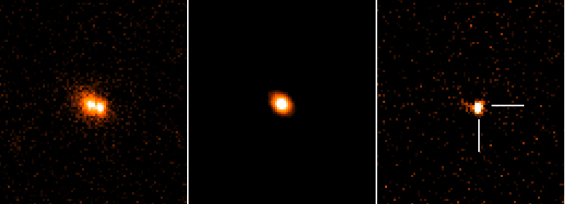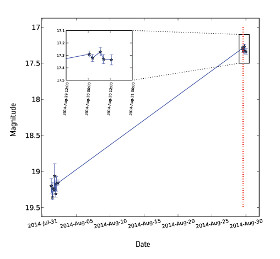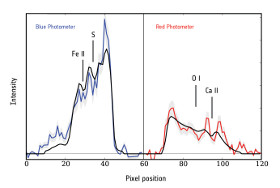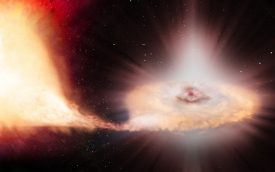Gaia discovers its first supernova
12 September 2014
While scanning the sky to measure the positions and movements of stars in our Galaxy, Gaia has discovered its first stellar explosion in another galaxy far, far away.
 |
| Supernova Gaia14aaa and its host galaxy. Credit: M. Fraser/S. Hodgkin/L. Wyrzykowski/H. Campbell/N. Blagorodnova/Z. Kostrzewa-Rutkowska/Liverpool Telescope/SDSS |
This powerful event, now named Gaia14aaa, took place in a distant galaxy some 500 million light-years away, and was revealed via a sudden rise in the galaxy's brightness between two Gaia observations separated by one month.
Gaia, which began its scientific work on 25 July, repeatedly scans the entire sky, so that each of the roughly one billion stars in the final catalogue will be examined an average of 70 times over the next five years.
"This kind of repeated survey comes in handy for studying the changeable nature of the sky," comments Simon Hodgkin from the Institute of Astronomy in Cambridge, UK.
Many astronomical sources are variable: some exhibit a regular pattern, with a periodically rising and declining brightness, while others may undergo sudden and dramatic changes.
"As Gaia goes back to each patch of the sky over and over, we have a chance to spot thousands of 'guest stars' on the celestial tapestry," notes Dr Hodgkin. "These transient sources can be signposts to some of the most powerful phenomena in the Universe, like this supernova."
Dr Hodgkin is part of Gaia's Science Alert Team, which includes astronomers from the Universities of Cambridge, UK, and Warsaw, Poland, who are combing through the scans in search of unexpected changes.
 |
|
Discovery of supernova Gaia14aaa. Credit: ESA/Gaia/DPAC/Z. Kostrzewa-Rutkowska (Warsaw University Astronomical Observatory) & G. Rixon (Institute of Astronomy, Cambridge) |
It did not take long until they found the first 'anomaly' in the form of a sudden spike in the light coming from a distant galaxy, detected on 30 August. The same galaxy appeared much dimmer when Gaia first looked at it just a month before.
"We immediately thought it might be a supernova, but needed more clues to back up our claim," explains Łukasz Wyrzykowski from the Warsaw University Astronomical Observatory, Poland.
Other powerful cosmic events may resemble a supernova in a distant galaxy, such as outbursts caused by the mass-devouring supermassive black hole at the galaxy centre.
However, in Gaia14aaa, the position of the bright spot of light was slightly offset from the galaxy's core, suggesting that it was unlikely to be related to a central black hole.
So, the astronomers looked for more information in the light of this new source. Besides recording the position and brightness of stars and galaxies, Gaia also splits their light to create a spectrum. In fact, Gaia uses two prisms spanning red and blue wavelength regions to produce a low-resolution spectrum that allows astronomers to seek signatures of the various chemical elements present in the source of that light.
 |
| Gaia spectrum of supernova Gaia14aaa. Credit: ESA/Gaia/DPAC/N. Blagorodnova, M. Fraser, H. Campbell, A. Hall (Institute of Astronomy, Cambridge) |
"In the spectrum of this source, we could already see the presence of iron and other elements that are known to be found in supernovas," says Nadejda Blagorodnova, a PhD student at the Institute of Astronomy in Cambridge.
In addition, the blue part of the spectrum appears significantly brighter than the red part, as expected in a supernova. And not just any supernova: the astronomers already suspected it might be a 'Type Ia' supernova – the explosion of a white dwarf locked in a binary system with a companion star.
While other types of supernovas are the explosive demises of massive stars, several times more massive than the Sun, Type Ia supernovas are the end product of their less massive counterparts.
Low-mass stars, with masses similar to the Sun's, end their lives gently, puffing up their outer layers and leaving behind a compact white dwarf. Their high density means that white dwarfs can exert an intense gravitational pull on a nearby companion star, accreting mass from it until the white dwarf reaches a critical mass that then sparks a violent explosion.
 |
| Artist's impression of a Type Ia supernova. Credit: ESA/ATG medialab/C. Carreau |
To confirm the nature of this supernova, the astronomers complemented the Gaia data with more observations from the ground, using the Isaac Newton Telescope (INT) and the robotic Liverpool Telescope on La Palma, in the Canary Islands, Spain.
A high-resolution spectrum, obtained on 3 September with the INT, confirmed not only that the explosion corresponds to a Type Ia supernova, but also provided an estimate of its distance. This proved that the supernova happened in the galaxy where it was observed.
"This is the first supernova in what we expect to be a long series of discoveries with Gaia," says Timo Prusti, ESA's Gaia Project Scientist.
Supernovas are rare events: only a couple of these explosions happen every century in a typical galaxy. But they are not so rare over the whole sky, if we take into account the hundreds of billions of galaxies that populate the Universe.
Astronomers in the Science Alert Team are currently getting acquainted with the data, testing and optimising their detection software. In a few months, they expect Gaia to discover about three new supernovas every day.
In addition to supernovas, Gaia will discover thousands of transient sources of other kinds – stellar explosions on smaller scale than supernovas, flares from young stars coming to life, outbursts caused by black holes that disrupt and devour a nearby star, and possibly some entirely new phenomena never seen before.
"The sky is ablaze with peculiar sources of light, and we are looking forward to probing plenty of those with Gaia in the coming years," concludes Dr Prusti.
Background Information
Gaia is an ESA mission to survey one billion stars in our Galaxy and local galactic neighbourhood in order to build the most precise 3D map of the Milky Way and answer questions about its origin and evolution. Gaia's scientific operations begun on 25 July 2014 with the special scanning through a narrow region in the sky, while the normal scanning procedure was switched on a month later, on 25 August.
The mission's primary scientific product will be a catalogue with the position, motion, brightness and colour of the surveyed stars. An intermediate version of the catalogue will be released in 2016. In the meantime, Gaia's observing strategy, with repeated scans of the entire sky, will allow the discovery and measurement of transient events across the sky.
This first such discovery is the Type Ia supernova described in this article, named Gaia14aaa. The name follows the convention used for naming transient astronomical sources, which acknowledges the name of the survey followed by the year of discovery and by a combination of letters to indicate the order of discovery. The supernova's host galaxy, SDSS J132102.26+453223.8, is about 500 million light-years away.
Converting the telemetry received from Gaia into scientific data products is the responsibility of the Gaia Data Processing and Analysis Consortium (DPAC). Within the Photometric Processing coordination unit of DPAC, the Science Alert Team is responsible for identifying transient sources.
During the first few months of Gaia's scientific operations, astronomers in the Science Alert Team will be compiling a preliminary catalogue of transients on a daily basis, depending on the data availability.
Follow-up observations from the ground to assess the nature of these sources will be carried out by the collaborating partners from Europe and elsewhere. Schools and amateur astronomers will also be involved in following up these targets.
Scientists from the Gaia mission and other astronomers studying transient events are gathered this week at the 5th Gaia Science Alerts Workshop, hosted at Warsaw University, Poland from 9 to 12 September 2014.
For further information, please contact:
Markus Bauer
ESA Science and Robotic Exploration Communication Officer
Tel: +31 71 565 6799
Mob: +31 61 594 3 954
Email: markus.bauer![]() esa.int
esa.int
Timo Prusti
Gaia Project Scientist
Email: timo.prusti![]() esa.int
esa.int
Simon Hodgkin
Institute of Astronomy
Cambridge, UK
Tel: +44 1223 766657
Email: sth![]() ast.cam.ac.uk
ast.cam.ac.uk
Łukasz Wyrzykowski
Warsaw University Astronomical Observatory
Warsaw, Poland
Tel: +48 608 648817
Email: lw![]() astrouw.edu.pl
astrouw.edu.pl
Nadejda Blagorodnova
Institute of Astronomy
Cambridge, UK
Tel: +44 1223 337548
Email: nblago![]() ast.cam.ac.uk
ast.cam.ac.uk




